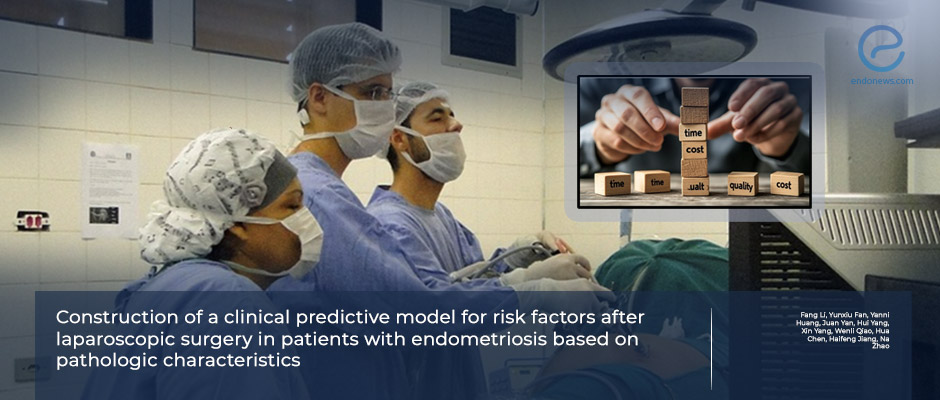Identifying recurrence risk before surgery: Pathological insights in endometriosis
Aug 15, 2025
Tumor board for endometriosis? Pathology points to reacurrence risk
Key Points
Importance:
- Recurrence after conservative surgery for endometriosis remains high, affecting up to 50% of patients within five years.
- Pelvic adhesions and inflammation from recurrent disease complicate secondary surgeries and increase postoperative risks.
Highlights:
- Independent preoperative predictors of recurrence include: Abnormal uterine bleeding, History of abortion, Advanced disease (ASRM stage III–IV), Palpable tender nodules in the posterior fornix.
- These features should be considered warning signs for increased recurrence risk after surgery.
- Effective postoperative hormonal management is critical; inadequate control can allow residual ectopic endometrial tissue to proliferate and shed again.
What's done here:
- A retrospective study conducted at Peking University First Hospital, China, aimed to evaluate the association between preoperative pathological characteristics and the risk of postoperative recurrence.
- Demographic and clinical data from 164 patients were collected over a two-year period from January 2022, and recurrence status was assessed during the one-year follow-up after laparoscopic surgery.
- Univariate and multivariable logistic regression analyses were performed to identify preoperative pathological features associated with recurrence.
Key Results:
- Recurrence occurred in 46 patients (28%) during the one-year follow-up. No significant differences were observed in demographic characteristics between recurrent and non-recurrent groups.
- Univariate analysis identified significant associations between recurrence and dysmenorrhea, ASRM stage, abnormal uterine bleeding, posterior fornix tender nodules, uterine enlargement, pathologic abortion, and delivery history.
- Multivariable logistic regression confirmed abortion history, abnormal uterine bleeding, ASRM stage ≥ III, and posterior fornix tender nodules as independent risk factors.
- A lower proportion of patients in the recurrent group had a history of childbirth compared to the non-recurrent group.
From the Editor-in-Chief – EndoNews
"This study underscores a truth that every gynecologic surgeon must keep front of mind: recurrence after conservative surgery for endometriosis is not merely a statistical inevitability—it is a foreseeable consequence in patients with identifiable preoperative risk factors. The presence of abnormal uterine bleeding, posterior fornix nodules, prior abortion, and advanced-stage disease is not just incidental history; it is a clinical warning siren.
Ignoring these signs risks sending patients down a predictable path toward repeat surgery, pelvic adhesions, increased operative complexity, and compromised fertility. The value of this work lies in its shift from reactive to proactive thinking: if we can identify those at highest risk before the first incision, we can tailor surgical aggressiveness, intensify postoperative hormonal suppression, and counsel patients with far greater precision.
The message is clear—recurrence prevention begins before the operation, not after. Integrating such risk stratification into routine preoperative assessment could transform long-term outcomes, reduce reoperation rates, and preserve quality of life for countless women."
Lay Summary
Endometriosis is an estrogen-dependent condition that worsens with each menstrual cycle through chronic inflammation and complex environmental interactions. This progression can lead to deep infiltrating lesions, severe pelvic pain, painful intercourse, gastrointestinal symptoms, and infertility.
Laparoscopic surgery remains the gold standard for confirming the diagnosis and removing disease tissue while preserving healthy structures to protect fertility. However, even after such conservative surgery, recurrence rates can reach up to 50% within five years—making prevention a key goal to avoid repeat operations and further compromise of reproductive potential.
To better understand factors that predispose to recurrence, Dr. Fang Li and colleagues at Peking University, China, conducted a two-year retrospective study including 164 women who underwent laparoscopic surgery starting in January 2022. Demographic and clinicopathologic data were analyzed, and recurrence was tracked during the first postoperative year.
Women who experienced recurrence were more likely to have a history of dysmenorrhea, pathological abortion, abnormal uterine bleeding, ASRM stage III–IV disease, uterine enlargement, and tender nodules in the posterior fornix. Multivariable analysis identified four independent preoperative risk factors: history of abortion, painful posterior fornix nodules, abnormal uterine bleeding, and advanced-stage endometriosis.
The authors conclude that targeted preoperative risk assessment and the development of a clinical predictive model could guide individualized surgical planning and postoperative strategies, ultimately helping to reduce recurrence risk.
This study was recently published in American Journal of Translational Research.
Research Source: https://pubmed.ncbi.nlm.nih.gov/40535644/
risk factors recurrence pathological features laparoscopic surgery line drawing model endometriois.

